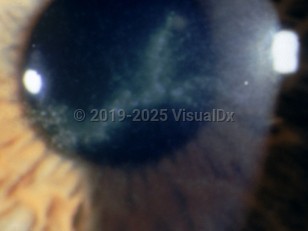Emergency: requires immediate attention
Acanthamoeba keratitis - External and Internal Eye
Alerts and Notices
Important News & Links
Synopsis

Emergent Care / Stabilization:
Acanthamoeba keratitis (AK) is a rare corneal infection that can be misdiagnosed as herpes simplex virus (HSV) infection. When the patient presents with corneal infection, the clinician should maintain a high index of suspicion for AK and consider a corneal culture before making the diagnosis of HSV infection. In addition, the clinician should be cautious about administering steroid eyedrops as this may promote the growth of amoeba.
Diagnosis Overview:
Acanthamoeba keratitis (AK) is a rare but serious eye infection that can affect a person of any age or sex. Because of its rarity, it can often be misdiagnosed in clinical settings. The incidence of AK is estimated to be approximately 1:250 000.
The Acanthamoeba organism exists in 2 forms in the cornea. The first form is the free-living protozoa called a trophozoite; the second is a cyst that is in resting or dormant stage.
Risk factors for AK include contact lens wear; use of homemade saline solution; exposure to nonchlorinated water while wearing contact lenses, such as in pools, hot tubs, rivers, and saunas; and exposure to vegetative matter or soil. Contact lenses (especially reusable soft lenses) have the potential to enable prolonged contact between the pathogens and the cornea. Among contact lens users, the risk of AK in reusable lens users is reported to be more than 3 times the risk in disposable lens users.
Patients with AK will present complaining of ocular pain, light sensitivity, red eyes, blepharospasm, excessive tearing, and possibly reduced vision. Often, especially in early disease, patients' symptoms will be more significant than what is seen on physical examination. The findings in AK can look very similar to viral keratitis caused by HSV or herpes zoster, and it is not uncommon for patients to be first treated unsuccessfully with antiviral and/or steroid medications for presumed HSV keratitis before the correct diagnosis of AK is made. Delayed diagnosis and misdiagnosis can lead to prolonged infection, potentially necessitating surgical intervention or even resulting in blindness.
When dealing with keratitis in children, AK should be considered even without history of contact lens usage or trauma.
Acanthamoeba infection can be disseminative in older adult or immunocompromised patients. Common complications involve cutaneous or pulmonary infections. Central nervous system infection is possible but is usually rare.
Acanthamoeba keratitis (AK) is a rare corneal infection that can be misdiagnosed as herpes simplex virus (HSV) infection. When the patient presents with corneal infection, the clinician should maintain a high index of suspicion for AK and consider a corneal culture before making the diagnosis of HSV infection. In addition, the clinician should be cautious about administering steroid eyedrops as this may promote the growth of amoeba.
Diagnosis Overview:
Acanthamoeba keratitis (AK) is a rare but serious eye infection that can affect a person of any age or sex. Because of its rarity, it can often be misdiagnosed in clinical settings. The incidence of AK is estimated to be approximately 1:250 000.
The Acanthamoeba organism exists in 2 forms in the cornea. The first form is the free-living protozoa called a trophozoite; the second is a cyst that is in resting or dormant stage.
Risk factors for AK include contact lens wear; use of homemade saline solution; exposure to nonchlorinated water while wearing contact lenses, such as in pools, hot tubs, rivers, and saunas; and exposure to vegetative matter or soil. Contact lenses (especially reusable soft lenses) have the potential to enable prolonged contact between the pathogens and the cornea. Among contact lens users, the risk of AK in reusable lens users is reported to be more than 3 times the risk in disposable lens users.
Patients with AK will present complaining of ocular pain, light sensitivity, red eyes, blepharospasm, excessive tearing, and possibly reduced vision. Often, especially in early disease, patients' symptoms will be more significant than what is seen on physical examination. The findings in AK can look very similar to viral keratitis caused by HSV or herpes zoster, and it is not uncommon for patients to be first treated unsuccessfully with antiviral and/or steroid medications for presumed HSV keratitis before the correct diagnosis of AK is made. Delayed diagnosis and misdiagnosis can lead to prolonged infection, potentially necessitating surgical intervention or even resulting in blindness.
When dealing with keratitis in children, AK should be considered even without history of contact lens usage or trauma.
Acanthamoeba infection can be disseminative in older adult or immunocompromised patients. Common complications involve cutaneous or pulmonary infections. Central nervous system infection is possible but is usually rare.
Codes
ICD10CM:
B60.13 – Keratoconjunctivitis due to Acanthamoeba
SNOMEDCT:
231896005 – Acanthamoeba keratitis
B60.13 – Keratoconjunctivitis due to Acanthamoeba
SNOMEDCT:
231896005 – Acanthamoeba keratitis
Look For
Subscription Required
Diagnostic Pearls
Subscription Required
Differential Diagnosis & Pitfalls

To perform a comparison, select diagnoses from the classic differential
Subscription Required
Best Tests
Subscription Required
Management Pearls
Subscription Required
Therapy
Subscription Required
References
Subscription Required
Last Reviewed:03/01/2025
Last Updated:03/19/2025
Last Updated:03/19/2025
Emergency: requires immediate attention
Acanthamoeba keratitis - External and Internal Eye

